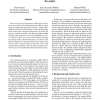Free Online Productivity Tools
i2Speak
i2Symbol
i2OCR
iTex2Img
iWeb2Print
iWeb2Shot
i2Type
iPdf2Split
iPdf2Merge
i2Bopomofo
i2Arabic
i2Style
i2Image
i2PDF
iLatex2Rtf
Sci2ools
89
Voted
AINA
2006
IEEE
2006
IEEE
BPB: A method for transparently obtaining network path characteristics close to the sender
Due to the growth of unresponsive UDP traffic in the Internet, it becomes increasingly important for ISPs to amply shape the traffic that leaves their network. Ideally, flows should be forced to be TCP-friendly; to this end, knowledge about certain end-to-end path characteristics is needed. We present a suitable mechanism (the Burst-PiggyBack (BPB) technique) that obtains the necessary information at a device that is located close to the sender without requiring any changes at the communicating peers or in routers. The method's hypothesis is that an injected probe packet at the end of a burst is treated similar to the burst. The results acquired from simulations showed strong correlations between the loss rate and the RTT of bursts and probe packets.
AINA 2006 | Certain End-to-end Path | Computer Networks | Probe Packets | Unresponsive Udp Traffic |
| Added | 20 Aug 2010 |
| Updated | 20 Aug 2010 |
| Type | Conference |
| Year | 2006 |
| Where | AINA |
| Authors | Sven Hessler, Jean-Alexander Müller, Michael Welzl |
Comments (0)

